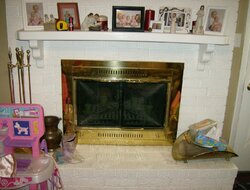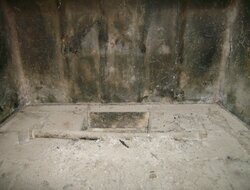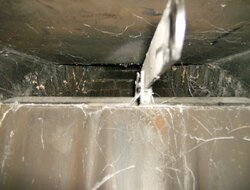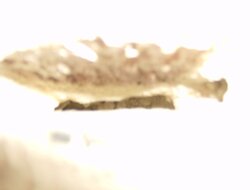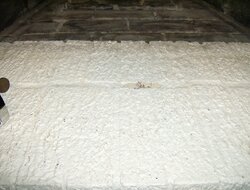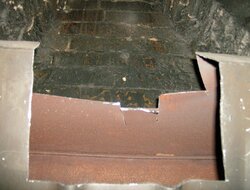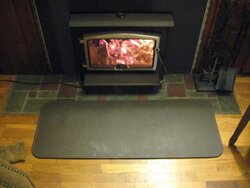Got the damper cut out and the liner opened up. Little bit of a hack job on the upper shelf but I was just glad to get that thing cut out. I I made the opening aproximately 9 inches wide. I'm afraid I'll feel some new muscles in the morning. (haha) Is there another simple solution to the hearth Pete? I was just thinking about putting one of those fire resistant mats in front to it and calling it good.
Phil:
Looks like you did a pretty good job cutting out that HeatForm. You are about ready to go...
Regarding floor protection and the use of mats, there are two factors to consider: ember protection and thermal protection. The stove manufacture will have certain specification for thermal protection, which normally meets ember protection as well. You didn't mention pulling a building permit for this job, which is often required in many jurisdictions. I mention this only because the building codes will often defer to the manufacture's requirements. That is, a code compliant job will meet the manufacturer's specs. There may not be specific language in the code that addresses a point in question.
Often a building inspector sent out to enforce the code may not be knowledgable in requirements for woodstoves, inserts, fireplaces, etc. That person may request to see a copy of the manufacturer's instructions and will use that as his/her set of code requirements.
Here is what the Heart Handbook for Building Officials: Solid Fuel Systems says about fire resistant mats:
page 22,
W3.3 Floor Portection
"Floor protection under a woodstove and the minimum extension distance around the woodstove must be considered carefully. Manufacturers use different testing methods to determine the floor protection requirements that are then included in their installation manuals. Some wood heaters are tested without thermal protection under them, so their instructions show only the required dimensions and position of the floor protection, which serves basically as spark/ember protection.
Other woodstoves are tested with a defined thickness of floor protection that has a certain resistance to the flow of heat through it. Stoves tested in this manner must show in their instruction the minimum thermal protection value (expressed in K, thermal conductivity, or in R, thermal resistance), how to calculate this protection for alternate materials, as well as the dimensions of the floor protection.
Some companies offer a listed floor protection (stove board or hearth pad). The safety standard to which they are listed is in transition from its status as a UL "outline of Investigation" to full standard status. Hearth pads tested to the outline of investigation may not be tested for thermal protection, or if tested, may not include the specific k or R factor attained in testing. Some of these products may contain combustible materials. As such, they are adequate for spark/ember protection, but not for thermal protrction required by the listing of some woodsatoves. And it may not be possible to determine whether thermally tested pads provide adequate thermal protection for some woodstoves if the specific k/R factors are not provided.
As the full UL 1618 standard is used by manufacturers, the listing will indicate whether the pad/board is only for spark/ember protection... or also provides thermal protection...."
This section on floor protection goes on but I think that you get the gist of it. Let the buyer beware. It's up to you to determine if the pad/board that you buy meets the stove manufacturer's requirements. I do know this: a hearth pad will not meet IRC building code requirements for new construction.
There is another problem with hearth pads: There are not typically nailed down, screwed down or glued down. So they can be kicked out of place. You can also trip over them. A better solution is a new hearth extension that meets the spark and thermal protection required by the stove manufacturer.
I wish you continued good luck with your install...
